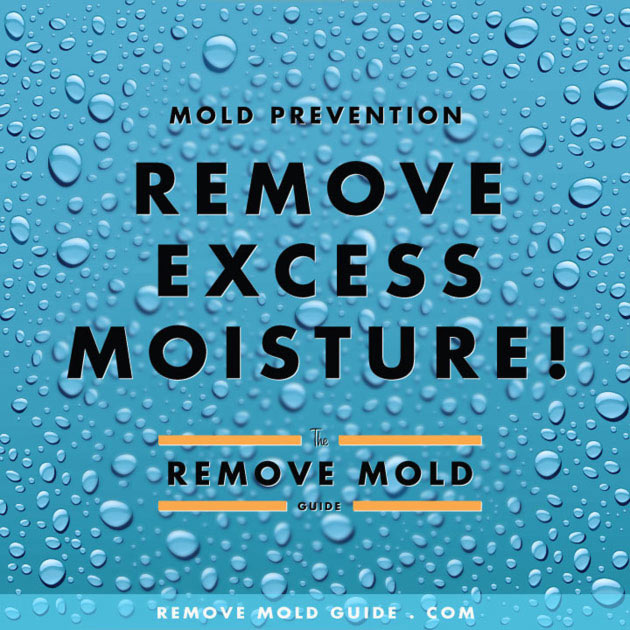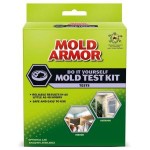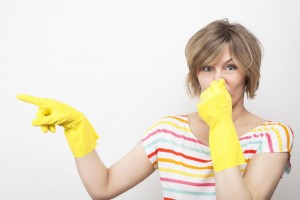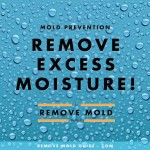The focus of this website is to help you remediate your mold problem because, well, even non-toxic molds are unwanted, right!? Left to its own devices, a mold infestation will continue to grow in size and severity. So we are going to focus more on the importance of removing mold, and how to do it. If you want to conduct further research on the details of toxic mold, however, you can search the internet for the five major types that typically grow indoors. They are Stachybotrys, Cladosporium, Aspergillus, Penicillium, and Fusarium. Some good places to start your in-depth research on these funky fungi are at Wikipedia or Doctorfungus.org.
You can find a ton of information on the internet regarding the various species of mold and their effects on human health. The types of mold that you should be most concerned with in your home are “toxic molds”. Keep in mind, however, that even non-toxic molds can cause health problems, especially in young children, elderly adults, and those with compromised immune systems or chronic lung diseases, such as asthma. Many people use the term “black mold” to describe toxic mold because many toxic molds appear black in color. Toxic molds appear in other colors than black, however, so don’t judge a mold by its color.
All mold is bad for your house, so normally you do not need to test the mold in your house to see what kind it is, but If you want to do it, you can purchase a do-it-yourself kit or have a test done by a competent professional. You can contact a local mold remediation service to see if they will test it for you. If you want to hire a professional, you should check out the Hiring a Pro section of our website.
Health Problems From Mold Exposure
 Regardless of the type of mold in your home, the primary hazard is its impact on your health. The majority of health problems associated with exposure to mold include allergic reactions, such as nasal stuffiness or eye irritation, and problems associated with the lungs. This is because the mold generates tiny spores that float through the air and get on your skin or enter your lungs. Check out the Health Impacts page for a more in-depth discussion of the health impacts of mold exposure.
Regardless of the type of mold in your home, the primary hazard is its impact on your health. The majority of health problems associated with exposure to mold include allergic reactions, such as nasal stuffiness or eye irritation, and problems associated with the lungs. This is because the mold generates tiny spores that float through the air and get on your skin or enter your lungs. Check out the Health Impacts page for a more in-depth discussion of the health impacts of mold exposure.
The Most Common Molds
According to the Centers for Disease Control (CDC), the most common molds found inside homes and buildings are Cladosporium, Penicillium, Aspergillus, and Alternaria. Below is a brief discussion of each.
Cladosporium commonly exists in the outdoor and indoor environment. Illness through exposure to Cladosporium is very rare, but has been known to cause infections, including skin, eye, and sinus infections. Fungal Meningitis is a more severe illness from exposure to Cladosporium. There has been an outbreak of fungal meningitis in several states recently, but this was associated with contaminated medical steroid injections, not from common exposure in homes and buildings.
Penicillium is one of the most common types of mold in indoor environments. It thrives on organic material such as food and soil particles (think of moldy bread or fruit). Unless you eat it, exposure to Penicillium carries the same health hazards as most molds, including skin, eye, or respiratory irritation. Ingesting it, however, can cause serious illness. Those with hypersensitivity or a compromised immune system may also experience more severe reactions just by exposure to airborne Penicillium.
Aspergillus is also a very common type of mold and exists in any oxygen-rich environments, and can typically be seen growing on starchy foods and outdoors on trees and plants. To healthy humans, moderate exposure typically does not have serious consequences, other than maybe some allergic reactions or irritations. Those with compromised immune systems, especially those with chronic lung diseases, can experience severe health problems from exposure to Apergillus.
Alternaria is a common allergen, and usually produces mild symptoms such as skin or eye irritation, or ” hay fever”. It can cause asthma, and like other mold types, can cause more serious problems in those with compromised immune systems. Alternaria is usually green, black, or gray in color. It is known to cause spoilage in plants used for food and, like other mold types, is very common in the outdoor environment and typically does not cause problems to humans in the outdoors.
Prevalence of Mold
According to a 2009 World Health Organization report, signs of dampness existed in 20% of homes in the United States, Canada, and Europe combined. It also referenced a study that indicated that in the United States alone, varying levels of dampness or mold existed in 50% of homes. The prevalence of mold is much higher in areas with higher humidity, such as along shorelines and river valleys. It just so happens that a large percentage of the population, both in the U.S. and in other countries, live in areas with higher humidity. According to the National Oceanic and Atmospheric Administration, 39% of the U.S. population lives in counties on the coast. Many more live just off the coastal area and in large river valleys, such as the Ohio and Mississippi rivers.

Several studies suggest that the prevalence of mold is also higher in lower-income areas because you tend to find more poorly maintained dwellings and buildings in these areas.
There is less research on the prevalence of mold in other buildings, such as schools, day cares, offices, and other similar buildings. Suffice it to say, however, that many people spend a majority of their time indoors, whether in their homes or in other buildings. Proper maintenance of buildings, especially plumbing and HVAC systems, is a key indicator of low mold levels and better indoor air quality.
How Mold Spreads
Once a mold colony has been established, it will produce spores that it releases into the air. The spores can also travel in water and sometimes can be transported by small insects. The spores will land on a surface, and if conditions are right it will begin to grow tiny roots and reproduce into another colony. In order for the spore to grow, it typically needs the following:
- Food source, usually organic material
- Moisture
- A stable place to grow
The food source is typically organic material, such as wood products, plant material, or pretty much anything that comes from a living organism. It doesn’t take much. Mold can grow on a small layer of dust if conditions are right.
The primary factor in mold growth is moisture. If an area is damp, mold will almost certainly find a way to grow. If that moisture is removed, however, the mold will become dormant and will not grow any further unless the right moisture levels return. That is why it is important to fix the moisture problem when cleaning mold from your home.
Finally, most indoor molds prefer to grow in dark, sedentary spaces. Even though mold can grow in high-traffic areas, it tends to be disrupted before a large colony can take hold. Air movement and moving objects, such as boxes or furniture, change the environment so that mold has a difficulty getting established. This is not a primary factor, however, in preventing mold. If the mold has become established, and you start moving things around, it will probably increase the chances of the mold spores being spread through the air to other places in the room and on your clothing because the spores will be released into the air.
How To Detect Mold
There are many ways to detect mold, ranging from sophisticated laboratory test kits to the use of your good old sniffer. Other than the obvious visual presence of mold, there are four other methods of mold detections:
- Allergies in the Home: If you notice that you are experiencing allergy symptoms only within you home, it may be due to the presence of mold. Keep in mind that other factors, such as pet dander, can cause these symptoms. If you can’t narrow it down to something else, you might have a growing mold problem somewhere in the house.
-
Home Mold Test Kit: Generally speaking, you shouldn’t have to use a test kit to address your mold problem. Almost all molds can be cleaned up the same way. If you are having trouble detecting mold, however, or if you want to know the type of mold that is present in your home, then a test kit can help. You can typically purchase these at your local hardware store, or you can purchase some top rated kits here. The kits typically require that you collect samples and send them to a lab which, for a fee, provides an analysis of your mold.
-
Odor Detection: Yes, sometimes the best way to identify your mold problem is to use your own sniffer. Getting down on your hands and knees and sniffing around is not only effective, but is a method sometimes used by professionals. Try hooking up a fan in the window, facing it so it blows out of the window, and seal up any draft areas such as under the door in the room. This removes the air in the room. Then go around and see if you can detect the mold by sniffing around the room.
-
Presence of Moisture: When you are talking about indoors, if there is a constant or recurring moisture problem, you will probably have a mold problem. Key areas to look at are around plumbing facilities, HVAC units, and windows. Basements are especially common areas for mold growth.
*It may be dangerous and hazardous to your health to attempt household removal on your own. The content of this website is provided for general informational purposes only and is not intended as, nor should it be considered a substitute for, professional mold removal advice. To learn more, please read our Terms of Use.






Pingback: minneapolis paintball parks
I discovered mold growing up the walls in my master bedroom closet when I removed everything in the closet. Long story short, the floor (laminate boards) were buckling for many month which was caused by a pipe in the building wall (not any of the pipes in my own apartment).
I can only assume that the entire closet has been contaminated and I need to know if it’s safe to wear any item before it’s washed or drycleaned.
I don’t know if mold (spores) live on clothing. Please advise.
Some molds produce toxins. Research Stachybotrys. While wearing respiratory protection, seal the clothes in plastic bags. Also bag the clothes you are wearing when you bag the others. Then shower.
Have all the clothes professionally cleaned.
Again while wearing protection, wipe the closet with a bleach and water solution, then dry and ventilate the area. Blow fresh outside air in and exhaust air outdoors. This will quickly reduce the spore count.
Remove all discolored building materials and treat the area with borate. Borate is inexpensive and easy to make yourself.
The new wood and walls can be painted as soon as the borate is dry. Usually sever days after application.
Or, if the landlord/insurance company will pay, have a professional mold remediation company do everything.
I have a wood carving that was put in a plastic bag to prevent drying out with a damp cloth… and forgotten! Found the bag and looked in it. Its covered with a white filmy mold (looks like cobwebs. Is this removable/salvageable?
Thank you.